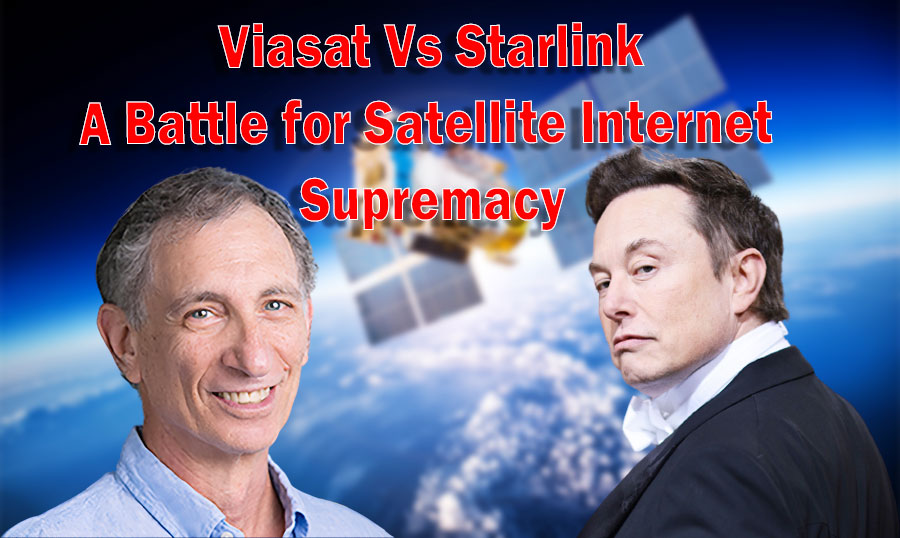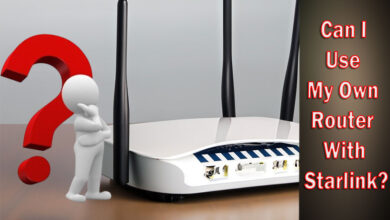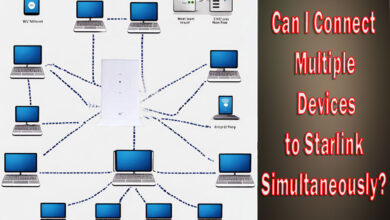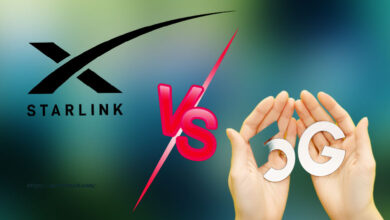Viasat Vs Starlink: A Battle for Satellite Internet Supremacy

Starlink offers more data, but it’s not yet available nationwide and has complaints of inconsistent reliability. Viasat is available nationwide but costs more per month even after factoring in the up-front cost of buying Starlink equipment.
In the battle of satellite internet providers, Starlink and Viasat are two major competitors. While Starlink offers more data and faster speeds, it is also more expensive and has limited availability. On the other hand, Viasat is available nationwide but has slower speeds and higher prices.
In terms of reliability, Starlink has faced complaints, whereas Viasat has a more established reputation. Both providers have their strengths and weaknesses, and the choice between them ultimately depends on the specific needs and location of the user.
High-Speed Satellite Internet Showdown: Viasat Vs. Starlink
In the high-speed satellite internet showdown between Viasat and Starlink, both providers have their strengths and weaknesses. While Viasat offers nationwide coverage, Starlink boasts faster speeds and more data, albeit with limited availability and higher upfront costs. For those seeking reliable satellite internet, the decision between Viasat and Starlink will depend on their specific needs and priorities.
Are you looking for high-speed satellite internet options but can’t decide between Viasat and Starlink? Look no further! We’ll compare these two popular providers to help you make an informed decision. Let’s dive in and explore the key differences between Viasat and Starlink.
Coverage And Availability
- Viasat: Available nationwide in the U.S.
- Starlink: Not yet available nationwide in the U.S.
Speed And Performance
- Viasat: Offers various plans with speeds ranging from 12 Mbps to 100 Mbps.
- Starlink: Known for its faster speeds with speeds potentially reaching up to 300 Mbps.
Data Limits
- Viasat: Data caps range from 40 GB to 300 GB per month, depending on the plan.
- Starlink: Offers unlimited data, but there may be some network management during peak times.
Reliability And Latency
- Viasat: Known for its reliable satellite internet service, but latency can be high due to the signal traveling a long distance.
- Starlink: Relatively new but aims to provide low-latency internet service with the help of its satellite constellation closer to Earth.
Equipment And Installation
- Viasat: Provides a dish and modem for installation, which may require professional assistance.
- Starlink: Requires a Starlink Kit, including a satellite dish, router, and modem, which can be self-installed.
Pricing And Cost
- Viasat: Offers different plans with prices ranging from $30 to $150 per month (excluding equipment and installation fees).
- Starlink: Currently in beta testing phase, with a one-time equipment fee of $499 and a monthly subscription fee of $99.
Customer Satisfaction
- Viasat: Known for its reliable service but has received customer complaints regarding inconsistent reliability.
- Starlink: Still in its early stages, but some users have reported positive experiences with its faster speeds.
Viasat and Starlink both offer high-speed satellite internet, but they differ in terms of coverage, speed, data limits, reliability, equipment, and pricing. When choosing between the two, consider your location, internet needs, and budget. It’s recommended to research further, compare plans, and read customer reviews to make an informed decision.
Understanding Satellite Internet: The Basics
Looking to compare Viasat and Starlink satellite internet providers? While Starlink offers more data and faster speeds, it’s not widely available yet and has received some reliability complaints. On the other hand, Viasat is available nationwide but comes at a higher monthly cost, even when considering the upfront equipment fees for Starlink.
Satellite internet is a type of internet connection that relies on satellite communication to provide internet access to users. Instead of using traditional wired connections like DSL or cable, satellite internet involves transmitting and receiving data signals between a user’s location and a satellite in space.
This technology allows people living in remote and rural areas to access the internet, where traditional forms of connectivity may not be available.
Here are some key points to understand about satellite internet:
- Coverage: Satellite internet is available almost everywhere, regardless of geographical location. It can reach remote areas that are not served by other types of internet connections.
- Speed: Satellite internet speeds have improved over the years, but they are still generally slower compared to other types of connections like fiber or cable. However, advancements, such as the deployment of low Earth orbit (LEO) satellite constellations like Starlink, are promising faster speeds in the future.
- Latency: Satellite internet is known for having higher latency due to the long distance that signals need to travel between the Earth and the satellite. This can result in noticeable delays during online activities like gaming or video conferencing.
- Data Caps: Many satellite internet plans come with data caps, which limit the amount of data you can consume within a specific period. Once you reach the cap, your internet speed may be reduced or your service may be temporarily suspended until the next billing cycle.
- Weather Impact: Adverse weather conditions, such as heavy rain or snow, can potentially affect the signal quality of satellite internet. This can result in temporary service disruptions or slower speeds during inclement weather.
It’s important to consider these factors when choosing a satellite internet provider. Now, let’s dive deeper into the differences between Viasat and Starlink, two popular satellite internet providers, in the following sections.
Coverage Area And Availability: Where Are They Accessible?
Viasat and Starlink are satellite internet providers, but there are key differences in their coverage areas and availability. Viasat offers nation-wide coverage in the United States, while Starlink is still in the process of expanding its coverage. Additionally, Starlink has received some customer complaints regarding its reliability, whereas Viasat is known for its consistent service.
Viasat and Starlink are two popular options for satellite internet providers, but their coverage areas and availability differ. Here’s a breakdown of where you can access each service:
Viasat:
- Viasat is available nationwide in the United States, providing coverage in both urban and rural areas.
- It offers reliable internet service to customers living in remote locations where other types of internet may not be available.
- Viasat’s coverage extends beyond the U.S., reaching some locations in Mexico and Central America as well.
Starlink:
- Starlink is still in the process of expanding its coverage area and is not yet available nationwide in the U.S.
- However, it has been rapidly deploying satellites and has begun offering beta service to certain regions.
- Currently, Starlink is primarily accessible in regions with lower latitudes, such as northern parts of the United States, southern Canada, and parts of the United Kingdom.
- Over time, Starlink plans to increase its coverage to include more areas around the world.
Both Viasat and Starlink are working to improve and expand their coverage areas, so it’s important to check their websites for the most up-to-date information on availability in your specific location.
Speed And Performance: Which One Reigns Supreme?
In the battle of speed and performance, Viasat and Starlink go head-to-head. Starlink offers more data and faster speeds, but availability is limited. On the other hand, Viasat is available nationwide but comes at a higher cost. A tough choice for satellite internet users.
When it comes to satellite internet providers, speed and performance are two crucial factors that can determine the overall user experience. In this section, we’ll compare the speed and performance of both Viasat and Starlink to see which one reigns supreme.
Let’s dive in:
Viasat:
- Viasat is available nationwide, making it a widely accessible option for users across the country.
- The speed of Viasat internet plans can vary depending on your location and the plan you choose.
- Viasat offers different packages with varying download speeds, ranging from 12 Mbps to 100 Mbps.
- However, it’s important to note that Viasat’s advertised speeds may not always be achievable during peak usage times or in certain areas with heavy congestion.
- Viasat’s performance can be affected by factors such as weather conditions and network congestion.
Starlink:
- Starlink is a new player in the satellite internet market, but it has gained significant attention due to its ambitious plans to provide global coverage.
- Starlink operates a constellation of low Earth orbit (LEO) satellites, which is expected to deliver faster and more reliable internet compared to traditional geostationary satellites.
- In terms of speed, Starlink claims to offer download speeds ranging from 50 Mbps to 150 Mbps, with the potential for even faster speeds in the future.
- Since Starlink is still in its beta phase, its availability is limited to certain regions and users need to join a waiting list to get access to the service.
- Early user reviews suggest that Starlink has the potential to deliver high speeds and low latency, but its performance may vary depending on factors like obstructions and interference.
Both Viasat and Starlink have their own strengths and limitations when it comes to speed and performance. While Viasat offers nationwide coverage and a range of plan options, Starlink’s emerging technology shows promise for faster and more reliable internet. However, it’s important to consider factors like availability, network congestion, and the ongoing development of Starlink’s infrastructure when making a decision.
Ultimately, the choice between the two will depend on your specific needs and location.
Equipment And Installation: What To Expect
When comparing Viasat and Starlink for equipment and installation, it’s important to consider the availability and reliability of both providers. While Starlink offers more data and faster speeds, it may not be available nationwide and has received some complaints about reliability.
Viasat, on the other hand, is available nationwide but may have higher monthly costs, even after factoring in the upfront cost of buying Starlink equipment.
When considering satellite internet providers like Viasat and Starlink, understanding the equipment and installation process is crucial. Here’s what you can expect:
- Viasat Equipment and Installation:
- Viasat provides a dish and modem as their standard equipment.
- A professional technician will handle the installation process, ensuring proper alignment and connection.
- The installation typically takes a few hours, and the technician will guide you through the setup.
- Starlink Equipment and Installation:
- Starlink provides a satellite dish, modem, and router as their equipment.
- The installation process is straightforward, and you can choose to self-install or request professional assistance.
- Self-installation involves connecting the equipment following the provided instructions, while professional installation ensures optimal performance.
- Equipment Costs and Rental:
- Viasat offers a lease option for their equipment, typically with a monthly fee.
- Starlink requires an upfront payment for their equipment, which includes the dish, modem, and router.
- Installation Time:
- Viasat installations usually take place within a few days after ordering, depending on technician availability.
- Starlink installations are currently limited due to high demand, so there may be a waiting period before installation.
- Location Requirements:
- Both Viasat and Starlink require a clear view of the sky for satellite communication.
- Viasat may have certain additional requirements depending on your location, such as the need for a taller mast if obstructed.
- Service Activation:
- Once the installation is complete, technicians will activate the service and ensure connectivity.
- You will receive instructions on setting up your network and connecting devices to enjoy internet access.
It’s important to note that the equipment and installation processes can vary based on your location and specific circumstances. It’s recommended to contact the respective providers for detailed information and personalized assistance.
Latency And Gaming: The Impact On Online Activities
When it comes to satellite internet providers, comparing Viasat and Starlink shows that Starlink offers more data and faster speeds, but it’s not yet available nationwide and reliability issues have been reported. Viasat, on the other hand, is available nationwide but has higher monthly costs.
Latency, or the delay between sending and receiving data, can significantly impact online activities, especially when it comes to gaming. Both Viasat and Starlink offer satellite internet services, but their performance in terms of latency can vary. Here’s a breakdown of how latency affects gaming and how Viasat and Starlink compare:
Viasat And Latency:
- Viasat’s satellite internet relies on geostationary satellites, which are positioned around 22,000 miles above Earth’s equator.
- The distance that the data has to travel to reach these satellites can result in higher latency.
- This higher latency can lead to noticeable delays during gaming, causing input lag and affecting the overall gaming experience.
- Despite this, Viasat works continuously to optimize its services and minimize latency for a smoother gaming experience.
Starlink And Latency:
- Starlink’s satellite internet system uses a constellation of low Earth orbit (LEO) satellites, which are positioned much closer to Earth, at around 340 miles above its surface.
- The shorter distance that the data has to travel results in lower latency compared to traditional geostationary satellite systems.
- This lower latency can translate to a more responsive and immersive gaming experience, especially in online multiplayer games.
- However, it’s important to note that Starlink is still in the early stages of deployment and further improvements can be expected in terms of latency.
While both Viasat and Starlink offer satellite internet services, Starlink’s use of LEO satellites gives it an advantage in terms of latency for online gaming. However, it’s important to consider other factors such as coverage and pricing before making a decision.
As technology continues to evolve, satellite internet providers are working to improve latency and provide a better gaming experience for users.
Pricing Plans And Packages: Comparing Costs
Comparing the costs of Viasat and Starlink, while Starlink offers more data and faster speeds, it is more expensive upfront due to equipment fees. On the other hand, Viasat is available nationwide but has higher monthly costs for its fastest plans.
When it comes to choosing a satellite internet provider, one of the key factors to consider is pricing. Both Viasat and Starlink offer different pricing plans and packages, catering to the diverse needs of their customers. Below, we will compare the costs associated with Viasat and Starlink to help you make an informed decision:
Viasat Pricing Plans And Packages:
- Viasat offers a range of internet plans with varying speeds and data allowances.
- The cost of Viasat plans starts at $50 per month for the lowest-tier plan, with speeds up to 12 Mbps and a data cap of 40 GB.
- Their mid-tier plan is priced at $100 per month, providing speeds up to 25 Mbps and a data cap of 60 GB.
- For users seeking faster speeds and more data, Viasat’s highest-tier plan is priced at $200 per month, offering speeds up to 50 Mbps and a data cap of 100 GB.
Starlink Pricing Plans And Packages:
- Starlink aims to provide high-speed internet access to underserved areas, but it is important to note that their service is not yet available nationwide in the U.S.
- The initial cost of Starlink equipment, including the satellite dish and modem, is $499, with an additional $99 for shipping and handling.
- Starlink’s monthly subscription fee is currently set at $99 per month.
- It’s important to keep in mind that while Starlink provides unlimited data, there might be occasional network congestion that could affect the internet speeds.
Comparing Costs:
- In terms of pricing, Viasat’s plans are generally more affordable than Starlink.
- However, it is essential to consider factors such as the speeds offered, data allowances, and availability in your area when making a decision.
- Viasat’s plans provide a range of options to suit different needs and budgets, while Starlink offers the advantage of unlimited data.
- It’s important to review the terms and conditions of each provider’s pricing plans to ensure you select the best option for your specific requirements and budget.
Considering the pricing plans and packages of both Viasat and Starlink will help you determine which satellite internet provider best aligns with your needs and budget. Remember to consider factors such as internet speeds, data allowances, and availability in your area before making a decision.
Customer Support And Reliability
Starlink and Viasat both offer customer support and reliability in their satellite internet services. While Starlink provides more data and faster speeds, it is not yet available nationwide and has received complaints about inconsistent reliability. On the other hand, Viasat is available nationwide but has higher costs.
When it comes to the customer support and reliability of Viasat and Starlink, there are several key factors to consider. Let’s take a closer look at each provider:
Viasat:
- Customer Support:
- Viasat provides 24/7 customer support via phone, chat, and email.
- Their customer support team is known for being responsive and helpful in resolving issues.
- Viasat also has an online support center with helpful articles and troubleshooting guides.
- Reliability:
- Viasat has been in the satellite internet industry for a long time and has built a reputation for reliable service.
- Their network is designed to withstand inclement weather conditions, such as heavy rain or snow.
- However, in some areas with high network congestion, customers may experience slower speeds during peak hours.
Starlink:
- Customer Support:
- Starlink offers customer support via email and an online support center.
- Currently, they do not have phone or chat support available.
- As a relatively new service, there may be limited customer support options compared to Viasat.
- Reliability:
- Starlink is still in the process of deploying its satellite network, and as a result, its reliability may vary.
- Some customers have reported inconsistent speeds and service interruptions.
- However, Starlink is continuously working to improve its network and address these issues.
Both Viasat and Starlink offer customer support options, but Viasat has a more established track record in terms of reliability. However, it’s important to remember that Starlink is still in its early stages and is actively working to improve its service.
Ultimately, the choice between the two providers will depend on your specific needs and location.
Future Prospects: Innovation And Expansion
In the battle between Viasat and Starlink, the future prospects for innovation and expansion are promising. While Starlink offers more data and faster speeds, Viasat is available nationwide and offers reliable service. Both satellite internet providers have their strengths, making it a tough choice for consumers.
The future prospects for both Viasat and Starlink are filled with promise and possibilities. Both companies are investing heavily in innovation and expanding their reach to provide better internet services to customers. Let’s take a closer look at how each company is planning for the future:
Viasat’s Future Prospects:
- Viasat is already an established player in the satellite internet market, with a nationwide presence in the United States.
- The company is continuously working on improving its technology and expanding its network capacity to provide faster and more reliable internet connections.
- Viasat is investing in advanced satellites, ground station upgrades, and network optimization to enhance the quality of its service and meet the growing demand for high-speed internet.
- Viasat is also exploring partnerships and collaborations with other companies to leverage their expertise and expand its services beyond residential customers, targeting sectors like government, aviation, and maritime.
- The company is committed to bridging the digital divide by bringing internet access to rural and underserved areas, ensuring that no one is left behind in the digital age.
Starlink’s Future Prospects:
- Starlink, a subsidiary of SpaceX, has made waves in the satellite internet industry with its ambitious plan to create a global broadband network.
- The company aims to launch thousands of low Earth orbit (LEO) satellites to provide high-speed internet coverage to even the most remote corners of the world.
- Starlink’s innovative satellite design and constellation architecture are paving the way for faster and lower-latency internet connections, rivaling traditional terrestrial broadband services.
- With its user terminal technology, Starlink is making it easier for customers to connect to its satellite network and enjoy high-speed internet without relying on ground-based infrastructure.
- The company’s future plans include launching the Starlink service in more countries and expanding its coverage areas, ensuring that people in rural and underserved areas get access to fast and reliable internet connections.
Both Viasat and Starlink have bold visions for the future, aiming to push the boundaries of satellite internet technology and bridge the digital divide. With their ongoing investments in innovation and expansion, these companies are positioning themselves to deliver cutting-edge internet services to customers worldwide.
Customers can look forward to faster speeds, lower latency, and wider coverage as Viasat and Starlink continue to evolve and grow.
User Feedback: Real Experiences With Viasat And Starlink
Get real user feedback and experiences with Viasat and Starlink in the Viasat vs. Starlink comparison. Discover the pros and cons of each satellite internet provider, including data availability, cost, and reliability. Don’t miss out on valuable insights before making your decision.
Satellite internet providers Viasat and Starlink offer users a chance to connect to the internet in rural areas where traditional broadband may not be available. However, when it comes to choosing the right provider, it’s essential to consider user feedback and real experiences.
Here, we’ll explore what users have to say about Viasat and Starlink, helping you make an informed decision.
Viasat User Feedback:
- Viasat offers nationwide coverage, making it accessible to users across the country.
- Some users appreciate the availability of different plans and options to choose from, allowing them to find a plan that suits their needs.
- Viasat offers reliable and consistent speeds for everyday internet usage, according to user reviews.
- However, there have been some complaints about slow speeds during peak congestion hours, which may impact activities like streaming or gaming.
- Users have praised Viasat’s customer service for being responsive and helpful when troubleshooting issues.
- The cost of the higher-tier plans can be on the expensive side compared to other satellite internet providers.
Starlink User Feedback:
- Starlink, while not yet available nationwide, has gained attention for its promise of high-speed internet and extensive coverage.
- Users who have access to Starlink have reported impressive speeds and low latency, making it suitable for tasks like online gaming and video conferencing.
- Starlink’s satellite dish and modem setup has received positive feedback for its ease of installation and self-alignment capabilities.
- Users have praised Starlink’s customer support, with reports of timely and helpful assistance when needed.
- However, there have been some reports of intermittent connection issues and service disruptions during extreme weather conditions, which may affect reliability.
- As a relatively new service, Starlink is still expanding its coverage, so not everyone can currently access their service.
Considering user feedback is crucial in making an informed decision about satellite internet providers like Viasat and Starlink. While Viasat offers nationwide coverage and reliability, Starlink shows promise with its high-speed connections and low latency. Ultimately, it’s essential to weigh the pros and cons and determine which provider suits your specific needs and location.

Credit: history-computer.com
Frequently Asked Questions Of Viasat Vs Starlink
Is Starlink Better Than Viasat?
Starlink offers more data, but it’s not available nationwide and has reliability complaints. Viasat is available nationwide but costs more than Starlink.
Is Viasat Worried About Starlink?
Viasat is concerned about Starlink due to light pollution from flying more satellites closer to Earth.
Who Is Starlink’s Biggest Competitor?
Starlink’s biggest competitor is Viasat due to their nationwide availability and competitive pricing.
Is Starlink The Best Satellite Internet?
Starlink offers more data and faster speeds than Viasat, but it’s more expensive upfront.
Conclusion
Overall, when comparing Viasat and Starlink as satellite internet providers, there are several factors to consider. Starlink offers more data and faster speeds, but its availability is limited and it has received customer complaints for inconsistent reliability. On the other hand, Viasat is available nationwide and offers reliable service, although its fastest plans come at a higher cost.
Ultimately, the choice between Viasat and Starlink depends on individual needs and priorities. If fast speeds and abundant data are a priority, Starlink may be the better option. However, if nationwide availability and reliable service are more important, Viasat may be the preferred choice.
It’s important to weigh the pros and cons of each provider and consider factors such as location, budget, and specific internet needs before making a decision. In the ever-evolving world of satellite internet, both Viasat and Starlink are making strides to provide better connectivity.
As technology continues to improve, it’s likely that both providers will continue to enhance their services and address any existing limitations. Whether it’s Viasat or Starlink, satellite internet can be a valuable alternative for those in rural or remote areas where traditional broadband options are limited.



